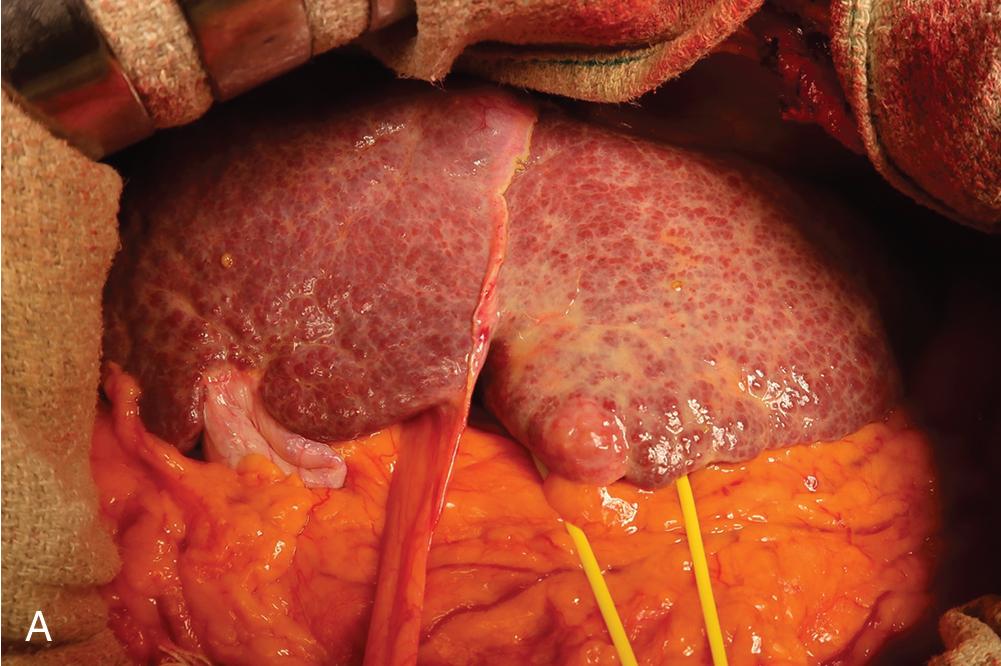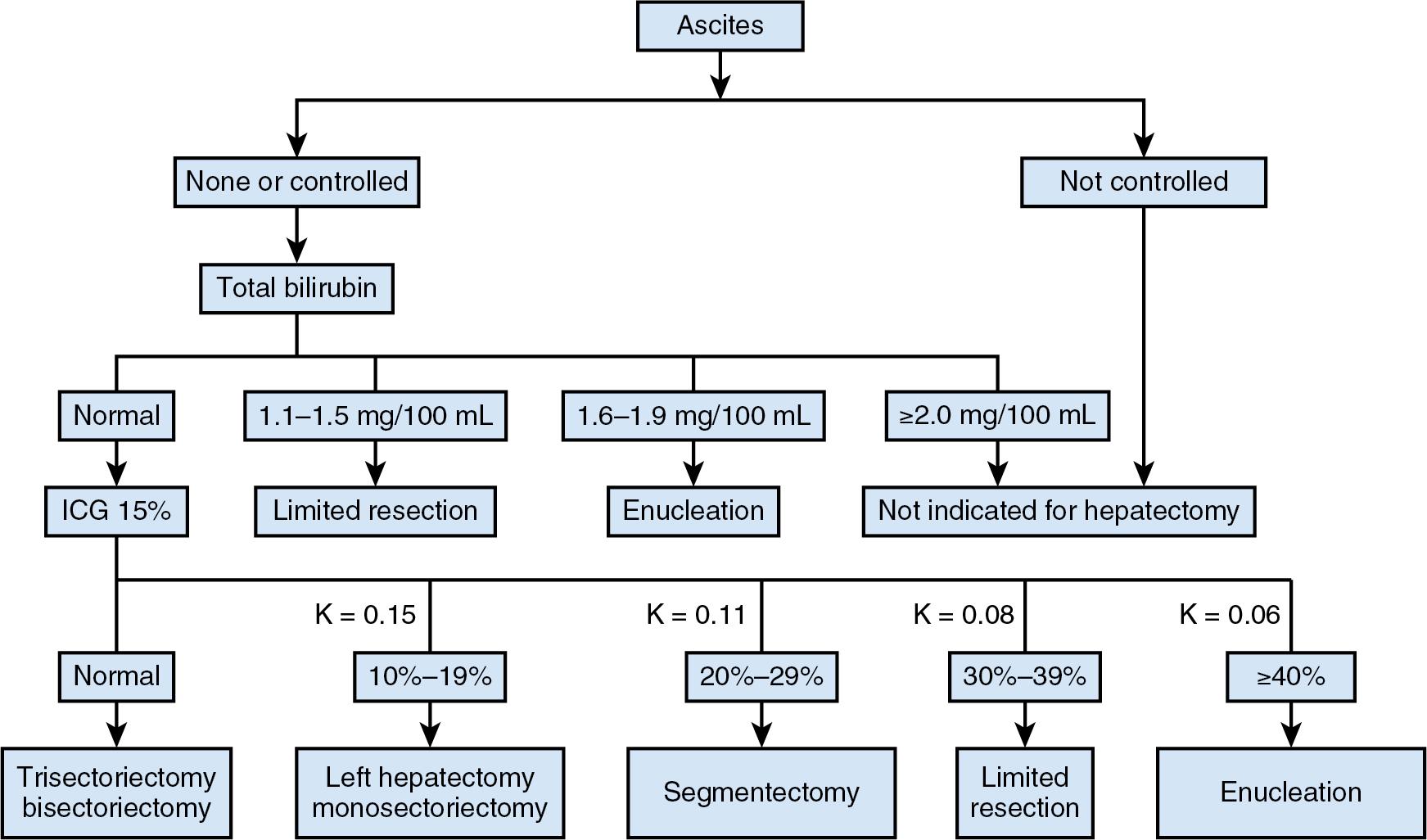Physical Address
304 North Cardinal St.
Dorchester Center, MA 02124
Local tumor control is still the most important consideration in the treatment of hepatocellular carcinoma (HCC), which is the most common diagnosis associated with hepatic resection in the setting of cirrhosis. Because liver resection can completely remove cancerous tissues, it is theoretically regarded as a curative treatment for HCC (see Chapter 89 ). Patients with HCC often have injured liver tissue or cirrhosis ( Fig. 120.1 A–B), and this factor should be taken into consideration when deciding on a therapeutic strategy for patients with HCC (see Chapters 68 , 69 , 74 , and 101B ). Liver transplantation is an ideal treatment for early-stage HCC (see Chapters 105 and 108A ), especially lesions meeting the Milan criteria and/or other expanded criteria for liver transplantation because all injured liver tissues with the potential to undergo carcinogenesis and the existing HCC can be removed. However, a severe graft shortage has sometimes made hepatic surgeons select liver resection as a first-line therapeutic strategy for HCC rather than liver transplantation. The safety of liver resection has been established, with a present mortality rate of 2% to 5%, even in patients with liver cirrhosis.

Prevention of any further deterioration in liver function is a second priority in the treatment of HCC. However, liver resection can be associated with significant blood loss and therefore remains technically demanding. To prevent fatal complications, such as liver failure, careful patient selection and meticulous perioperative management are essential (see Chapters 4 and 26 ). Because the extensive removal of noncancerous liver parenchyma should be avoided as much as possible, accurate evaluation of the liver volume to be removed and what to preserve is important when deciding on an appropriate procedure (see Chapter 4 ).
This chapter describes general aspects of liver resection for HCC in patients with cirrhosis, including surgical indication, perioperative management, and surgical techniques, especially focusing on the surgical techniques.
In Eastern countries, the indocyanine green retention rate at 15 minutes (ICG R15) is regarded as an important tool for assessing what liver volume to remove accurately. Especially in Japan, criteria consisting of the ICG R15 value, ascites, and jaundice (“Makuuchi’s criteria”) are widely used for decisions regarding surgical indications and to estimate tolerable resection volumes in cirrhotic patients ( Fig. 120.2 ).

In patients with uncontrollable ascites even after use of diuretics and/or a serum total bilirubin level constantly higher than 2.0 mg/dL, liver resection is absolutely contraindicated (see Chapters 77 and 79 ). When the serum total bilirubin level is 1.1 to 1.9 mg/dL, tumor enucleation or the resection of a small part of the liver is possible. If the level is 1.0 mg/dL or less, the surgical procedure can be determined based on the ICG R15 value. If the ICG R15 value is normal (<10%), a major hepatectomy (i.e., right hemihepatectomy, left trisegmentectomy, and central bisegmentectomy) may be feasible (see Chapter 118A ). In patients with a slightly injured liver (ICG R15 of 10%–19%), a one-third resection (left hemihepatectomy, or right lateral or paramedian sectionectomy) can be performed, but major hepatectomy would be associated with high risk. In patients with ICG R15 of 20% to 29%, a one-sixth resection corresponding to a left lateral section or one segment defined by Couinaud is possible. If ICG R15 is more than 30%, only a limited resection can be considered.
Torzilli and colleagues applied the previous criteria to 107 consecutive patients (59.8% cirrhosis) undergoing liver resection for HCC. As a result, the mortality and morbidity rates were 0% and 26.2%, respectively. According to a report investigating the relationship between preoperative liver function and postoperative complications in 127 patients with HCC, the ICG R15 value was confirmed to be the most significant factor for the prediction of mortality. Recently, some of the refined and expanded Makuuchi’s criteria are proposed with the accurate estimation of the remnant liver volume. ,
In general, a single and small HCC is a good indication for resection; however, multifocal and large lesions can also be treated by resection, providing satisfactory long-term outcomes (see Chapter 89 and 101B ). For advanced HCC with vascular invasion, liver resection can also offer acceptable results compared with the use of a molecular targeted agent (Sorafenib; see Chapters 89 and 99 ), which is recommended in the treatment algorithm of the Barcelona Clinic Liver Cancer (BCLC) group. Although this algorithm is considered to be the treatment standard worldwide, several investigators have objected to this algorithm, especially in regard to the extent of restrictions placed on the surgical indications. Consequently, several additional treatment algorithms are now available.
Portal hypertension, which was usually defined as a hepatic venous pressure gradient of 10 mm Hg or larger, can be practically diagnosed by the presence of esophageal varices and/or a platelet count of less than 100,000/μL in association with splenomegaly. In 1996 Bruix and colleagues reported that liver resection for HCC in patients with portal hypertension led to a high incidence of postoperative liver decompensation of as much as 73%, and their group recently published meta-analysis comparing prognosis after hepatectomy with and without portal hypertension, which concluded that portal hypertension increases the risk for mortality and clinical decompensation after surgery for HCC. Based on these results, the American and European guidelines concerning the management of HCC suggested that the presence of portal hypertension may be a contraindication for liver resection, and this recommendation is now widely accepted worldwide. , ,
Indeed, the prognosis for patients with portal hypertension after hepatectomy for HCC is considered relatively poor compared with that of patients without portal hypertension; however, several investigators have reported satisfactory long-term outcomes after hepatectomy for patients with portal hypertension who were not eligible for liver transplantation. , , , ,
Because comparable outcomes are difficult to obtain with other nonsurgical treatments, the surgical indications for HCC associated with portal hypertension should be discussed further. Discussion of the indication for hepatectomy in patients with portal hypertension should be based not on the comparison with or without portal hypertension among the patients who underwent hepatectomy but on the comparison with or without surgical treatment among the patients who have portal hypertension. Consequently, the BCLC guidelines may need to be modified in terms of the role of surgery.
To prevent refractory ascites and edema, the routine administration of spironolactone (aldosterone inhibitor) is recommended, especially in cirrhotic patients, because secondary hyperaldosteronemia is caused by a low degradation of aldosterone through liver metabolic dysfunction. The dose of spironolactone can be approximately decided based on the preoperative ICG R15 value; for example, 100 mg/day and 200 mg/day of spironolactone should be used in patients with ICG R15 values of less than 20% and more than 20%, respectively. If the ascites is uncontrollable, administration of furosemide is a better choice, with an initial dose of 10 or 20 mg/day.
Become a Clinical Tree membership for Full access and enjoy Unlimited articles
If you are a member. Log in here